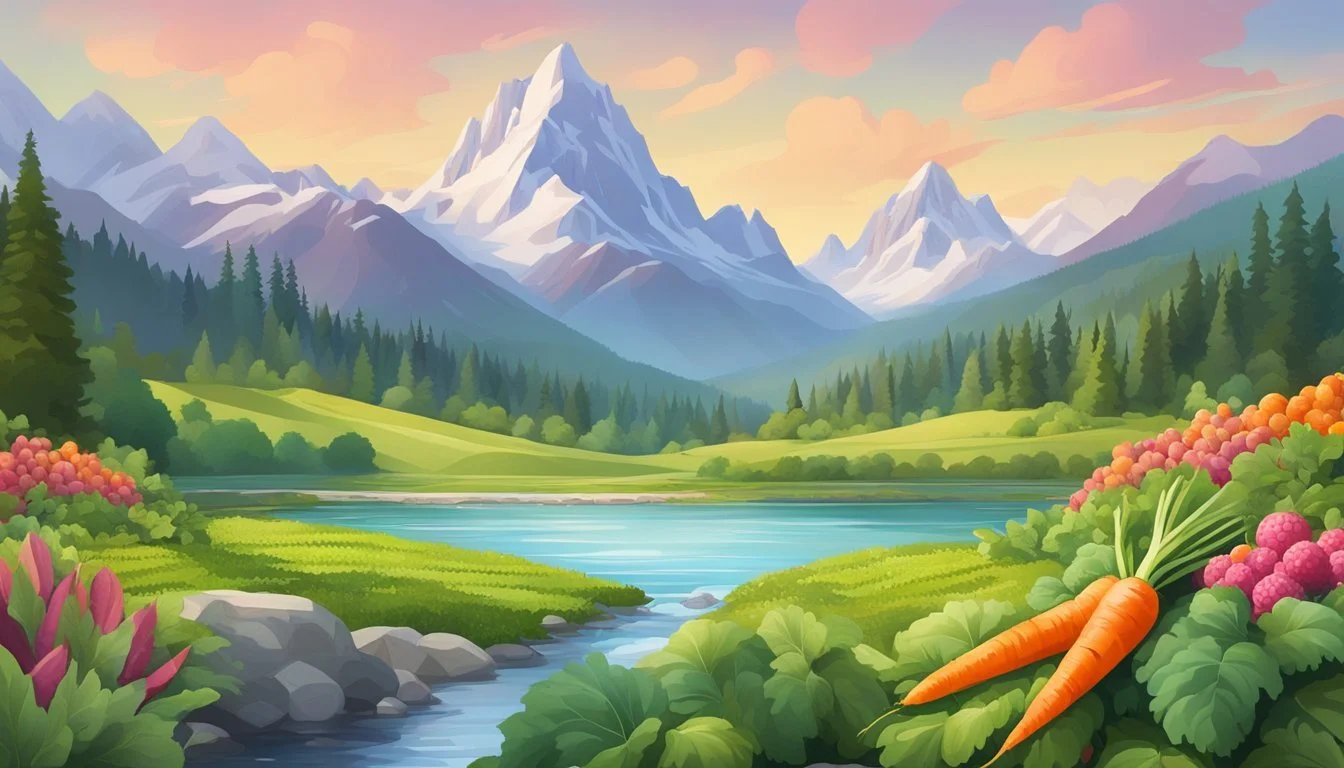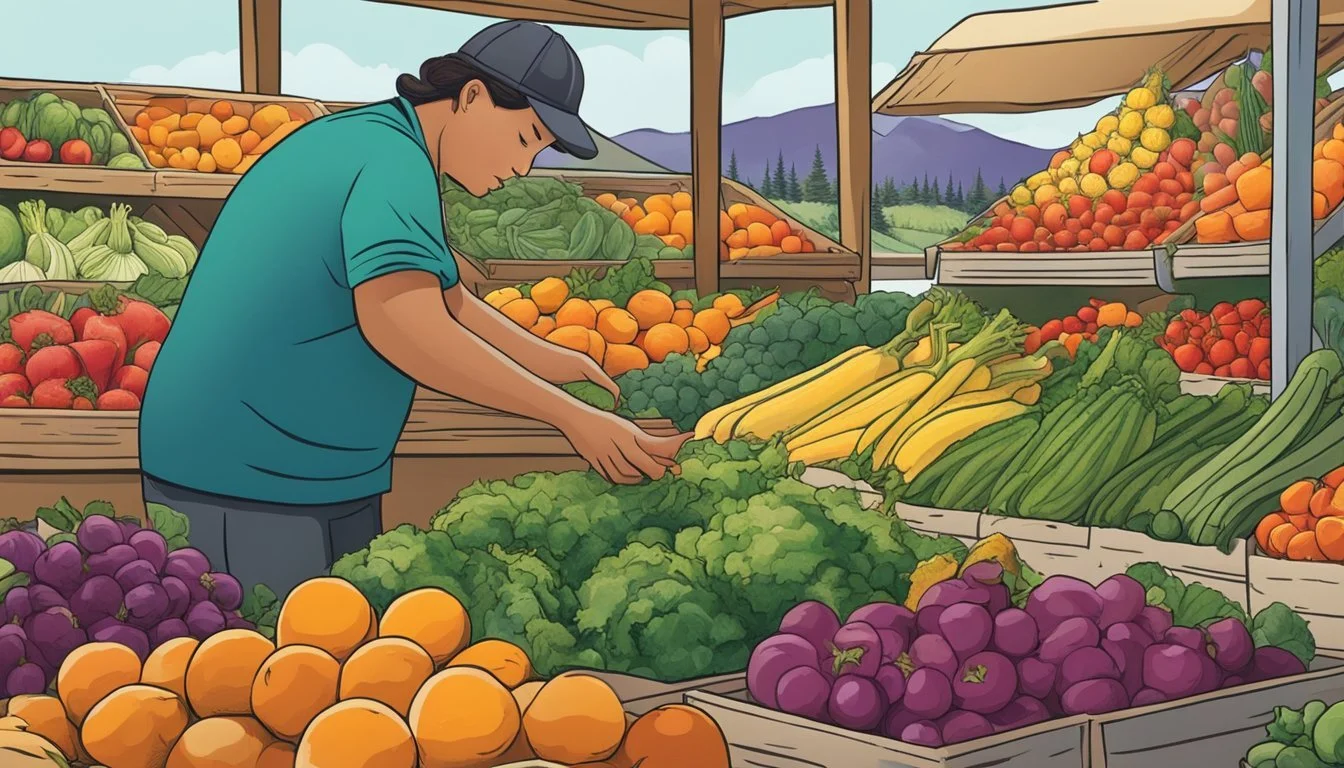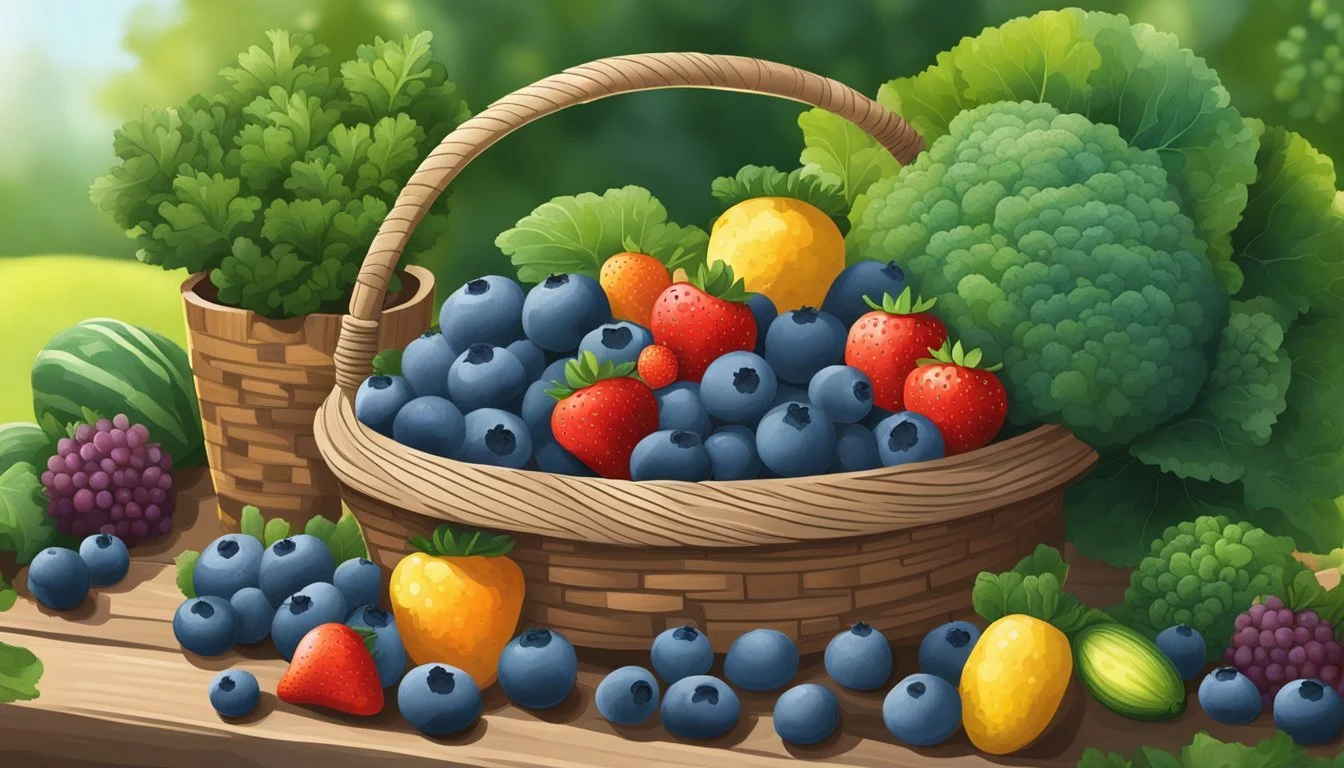Alaska Seasonal Fruit & Vegetables in August
Your Freshness Guide
This Article is Part of our Alaska Seasonal Fruit & Veg Calendar
August in Alaska marks a period of abundance for locally grown produce. As summer nears its peak, daytime lengths remain generous, providing ample sunlight for a variety of fruits and vegetables to flourish. Despite the state’s short growing season, the intense and prolonged periods of sunshine during these summer months result in a rapid growth cycle for many crops.
Alaska's summer climate is conducive to producing a rich array of seasonal fruits such as raspberries and lingonberries that reach their peak ripeness in late July and continue through early August. The cooler temperatures and unique daylight conditions give these berries a distinctive, robust flavor that is highly sought after.
Vegetables also thrive during the Alaskan August. Local gardens and farms offer fresh and crunchy produce, from peas and radishes to a diverse selection of leafy greens such as collard greens (how long do collard greens last?), kale, and chard. Root vegetables like carrots, potatoes, and onions, known for their storability, are harvested and can often be found fresh in the market or stored for use throughout the year. This time of the year is ideal for residents and visitors alike to experience the freshest and most flavorful produce Alaska has to offer.
What's in Season in Alaska
August in Alaska offers an abundance of fresh produce as the peak of the summer season brings a variety of vibrant fruits and vegetables to local markets. The long daylight hours provide excellent growing conditions, especially for a selection of berries and garden vegetables.
Fruit Highlights of August
Berries: August is prime time for berry picking in Alaska. One can find a bountiful harvest of blueberries, blackberries, and raspberries. The berries are often at their peak of ripeness, offering a perfect blend of sweetness and tartness.
Melons: While not as common due to the cooler climate, some growers might offer varieties of melons, including watermelon, which can be a sweet, refreshing treat this time of year.
Vegetable Highlights of August
Salad Vegetables: Crisp cucumbers (how long do cucumbers last?) and juicy tomatoes are readily available, making them perfect additions to any summer salad.
Starches and Squashes: Corn is a staple that starts to come into season, and zucchini, as well as eggplant (What wine goes well with eggplant?), can be found in abundance.
Peppers: A range of peppers from sweet to hot can add a burst of flavor and color to dishes.
Alaska Seasonal Food Benefits
In August, consumers in Alaska have access to a variety of seasonal produce that is ripe for harvest. These offerings provide superior nutritional content and a lower environmental impact, making them beneficial choices for both health and sustainability.
Nutritional Advantages
Seasonal fruits and vegetables harvested in August typically reach their nutritional peak, offering a higher concentration of vitamins, minerals, and antioxidants. Kale and greens, popular in Alaskan summers, are rich in vitamins A, C, and K, as well as fiber and iron. Including these in healthy recipes can contribute to a balanced diet. Conversely, summer squash, another local favorite, is low in calories yet high in vitamin B6 and magnesium, essential for a well-functioning body.
Kale: High in vitamin C, vitamin K
Greens: Abundant in iron, fiber
Summer Squash: Excellent source of vitamin B6, magnesium
Environmental Impact
The ecological footprint of consuming locally-grown produce during its natural growing season is considerably reduced. Transportation emissions are lower when foods are sourced locally rather than shipped from distant regions. An emphasis on local, seasonal selections like those available during the summer months underscores the importance of supporting regional agriculture and promoting a sustainable food system. This includes a reduction in packaging and preservation requirements, further diminishing the environmental impact.
Transport Emissions: Significantly reduced with local produce
Sustainable Agriculture: Supported by choosing seasonal items
Waste Reduction: Minimized packaging and preservation needs
Alaskan residents have the opportunity to enjoy fresh produce such as kale, greens, and summer squash during the summer season, which not only contributes positively to their health but also supports environmental sustainability.
Selecting and Storing Produce
August in Alaska brings with it an abundance of fresh produce, ranging from berries to a variety of vegetables. Understanding how to select the ripest offerings and employing correct storage methods ensures peak flavor and longevity.
Tips for Picking Fresh Produce
When selecting berries such as lingonberries or raspberries, one should look for bright, uniform color and avoid containers with juice stains which can indicate overripe fruit. For vegetables like onions, peas, and celery (how long does celery last?), firm texture and vibrant color are good indicators of freshness. Stone fruits, like any summer fruits, should have a slight give when gently pressed, signaling ripeness.
Storage Practices for Freshness
Berries: Store in the refrigerator in their original container or a shallow bowl covered with plastic wrap. They are best consumed within a few days.
Vegetables: Most vegetables, like onions, peas, and celery, should be stored in the crisper drawer of the refrigerator in a breathable bag.
Herbs: Keep herbs fresh by trimming the ends and placing them in a glass of water in the refrigerator, similar to flowers.
Stone Fruits and Apples: Place them on the counter if not fully ripe, and then transfer to the refrigerator once ripeness is achieved. Keep apples separate from other produce to prevent them from hastening the ripening of other items due to ethylene gas production.
By following these guidelines, one can enjoy the full flavor and nutritional benefits of Alaska's seasonal produce throughout August and beyond.
Culinary Inspiration for August
August offers a bounty of fresh fruits and vegetables in Alaska, from crisp cucumbers to juicy stone fruits. This is the prime time for chefs and home cooks to explore the vibrant flavors and textures of the season's produce through various recipes and creative culinary applications.
Seasonal Recipes
Alaska's August harvest provides an excellent opportunity for creating flavorful salads and healthy recipes. A classic Summer Squash Salad can be brightened with a handful of fresh cucumbers and ripe tomatoes, topped with a light vinaigrette. For dessert, one might turn to succulent stone fruits for inspiration, with Stone Fruit Desserts like homemade apricot pies or peach cobblers being seasonal favorites.
Cucumber and Tomato Salad: Thinly slice cucumbers and tomatoes, toss with a splash of olive oil, and season with salt and fresh herbs.
Grilled Summer Squash: Slice summer squash lengthwise, brush with olive oil, grill until tender, and sprinkle with your choice of seasonings.
Creative Ways to Use Summer Produce
In addition to raw preparations, August's produce can be transformed into comforting and creative dishes. Fresh cucumbers work well in chilled soups or as bases for refreshing sauces and pestos. One can grill eggplants to perfection and incorporate them into an Eggplant Parmesan (What wine goes well with eggplant parmesan?) or blend them into a smoky Baba Ganoush.
Baba Ganoush: Char eggplants on a grill, scoop out the insides, and blend with garlic, tahini, and lemon juice for a creamy dip.
Homemade Pesto: Use basil, garlic, pine nuts (how long do nuts last?), Parmesan cheese, and olive oil to craft a vibrant pesto sauce (how long does pesto sauce last?) that pairs beautifully with fresh pasta (how long does fresh pasta last?).
Throughout the month of August, Alaska's seasonal products inspire a myriad of delightful culinary creations that emphasize the peak freshness and flavor of summer's bounty.
Preparation for Late Summer Harvest
As the late summer month of August progresses in Alaska, gardeners shift their focus towards harvesting existing crops and preparing for the fall season. This period is crucial for both collecting the ready produce and ensuring a successful transition to the cooler months.
Transitioning to Fall Crops
Gardeners in Alaska make the most of August by starting the transition towards fall crops. Potatoes and carrots, Alaskan staples, should be monitored closely for signs of maturity. Green beans, another late summer favorite, will be nearing the end of their harvesting window. To prepare for fall, one should consider:
Planting: Cultivating cold-hardy vegetables that can withstand the early frosts, like kale and Brussels sprouts.
Soil Care: Enriching the soil with compost to replenish nutrients after the summer harvest.
Protection: Setting up coverings to protect the new crops from the increasingly colder nights.
Preserving the Bounty
Preserving the late summer harvest ensures a supply of nutritious local produce throughout the colder months. August calls for meticulous efforts in canning, freezing, and drying the bounty one has grown. Here’s how Alaskans can preserve their produce:
Canning: Sealing away fruits and vegetables like berries and cucumbers to enjoy in off-season months.
Method Produce Example Water Bath Berries Blueberry jam Pressure Vegetables Pickled carrots
Freezing: Blanching vegetables like beans and broccoli to retain flavor and texture.
Drying: Dehydrating herbs and certain fruits that can handle the process without losing too much flavor.
By utilizing these techniques, Alaskans can enjoy the flavors of their labor well into the snowy months, ensuring no part of the late summer harvest goes to waste.
Gardening Tips for August
As August arrives in Alaska, gardeners need to focus on maintenance and planning ahead for the changing seasons. This pivotal time ensures a bountiful harvest and prepares for the next growing cycle.
Maintaining a Healthy Garden
In Alaska, August is a critical month for tending to vegetables that thrive in cooler conditions. Gardeners should prioritize:
Watering: Keep the soil consistently moist for beans and summer squash, as these vegetables require ample water during their peak growing period.
Weeding: Regular weeding is essential to reduce competition for nutrients and water.
Pest Control: Be vigilant about pests, which can become prevalent in August. Natural deterrents or organic pesticides help protect your harvest.
Harvesting: Greens like lettuces are ready for picking. Harvesting them encourages new growth and maximizes yield.
Fertilizing: A balanced fertilizer can support growth, particularly for heavy feeders like winter squash.
Planning for Next Season
With the approach of fall, gardeners in Alaska should begin planning for the next season:
Planting Bulbs: Garlic and onions planted in August have a head start for the next year.
Adjusting Crops: Transition to cold-hardy crops suitable for the looming fall and winter conditions.
Soil Health: Begin prepping your soil for fall by adding compost to enrich it post-harvest.
Cover Crops: They can be sown to replenish and protect the soil throughout the winter months.







